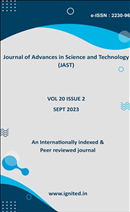Is AI the end of Human Creativity
DOI:
https://doi.org/10.29070/9qgeet16Keywords:
Artificial intelligence, human creativity, instrument, complement, expand, think creatively, emotionally, intuitively, automate, insights, creative problem solving, ground-breaking advances, arts, sciences, creative fields, secondary school kids, mean age, India, sustain life on Mars, class time, after-school activity, study participants, content analysis, essential questions, social, emotional, technical, learningAbstract
Artificial intelligence (AI) is not the end of human creativity but rather a potent instrument tocomplement and expand it. In contrast to humans, AI is limited in its ability to think creatively, emotionally,and intuitively. Working together with AI, we may take use of its features to automate mundane chores andobtain insights, leaving us more time and energy for creative problem solving. Instead of restricting humancreativity, combining it with AI technology might lead to ground-breaking advances in the arts, sciences,and other creative fields. Participants were 80 secondary school kids (mean age = 15) from variousschools throughout India. The question, How do we sustain life on Mars? was posed to the class. Sixtystudents were responsible for completing this assignment during class time. Twenty pupils participatedin this after-school activity. Study participants' perspectives on the question Is AI the end of humancreativity? were analysed. A content analysis of the students' answers to many essential questionsprovided insight into this issue. The findings show that the students had a firm grasp on four keyconcepts related to artificial intelligence and creativity social, emotional, technical, and learning.Downloads
References
King, R., Churchill, E.F., Tan, C.: Designing with Data: Improving the User Experience with A/B Testing. O’Reilly Media, Incorporated (2017)
Shidujaman, M., Mi, H.: “which country are you from?” A cross-cultural study on greeting interaction design for social robots. In: International Conference on Cross-Cultural Design, pp. 362–374 (2018)
Simonton, D.K.: Origins of Genius: Darwinian Perspectives on Creativity. Oxford University Press (1999)
Chen, W., Shidujaman, M., Jin, J., Ahmed, S.U.: A methodological approach to create interactive art in artificial intelligence. In: Stephanidis, C., et al. (eds.) HCII 2020. LNCS, vol. 12425, pp. 13–31. Springer, Cham (2020). https://doi.org/10.1007/978-3-030-60128-7_2
Frey, C.B., Osborne, M.A.: The Future of Employment. How Susceptible Are Jobs to Computerisation (2013)
PwC: Sizing the prize. What’s the real value of AI for your business and What’s the real value of AI for your business and how can you capitalise? (2017)
Mayssa A.A. Elfar (2023) on “Using Artificial Intelligence for Enhancing Human Creativity” https://doi.org/10.55554/2785-9649.1017 2785-9649/© 2023 Helwan University. This is an open access article under the CC-BY-NC-ND license (http://creativecommons.org/licenses/by-nc-nd/4.0/).
Zhuohao Wu1(B) , Danwen Ji2, Kaiwen Yu3, Xianxu Zeng4, Dingming Wu5, and Mohammad Shidujaman6 (2021) on “AI Creativity and the Human-AI Co-creation Model”© Springer Nature Switzerland AG 2021 M. Kurosu (Ed.): HCII 2021, LNCS 12762, pp. 171–190, 2021. https://doi.org/10.1007/978-3-030-78462-1_13
Gobet F and Sala G (2019) How Artifcial Intelligence Can Help Us Understand Human Creativity. Front. Psychol. 10:1401. doi: 10.3389/fpsyg.2019.01401
The Journal of Creative Behavior, Vol. 0, Iss. 0, pp. 1–13Ó2023 The Authors.The Journal of Creative Behaviorpublished by Wiley Periodicals LLC on behalf of Creative EducationFoundation (CEF). DOI: 10.1002/jocb.597This is an open access article under the terms of theCreative Commons Attribution-NonCommercial-NoDerivsLicense,






